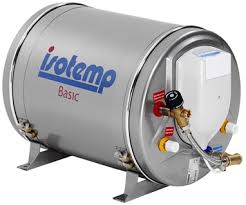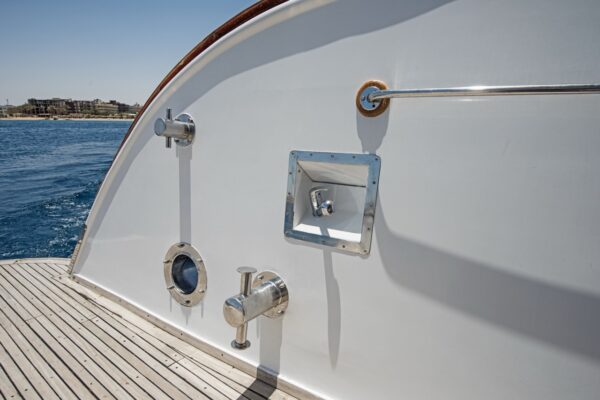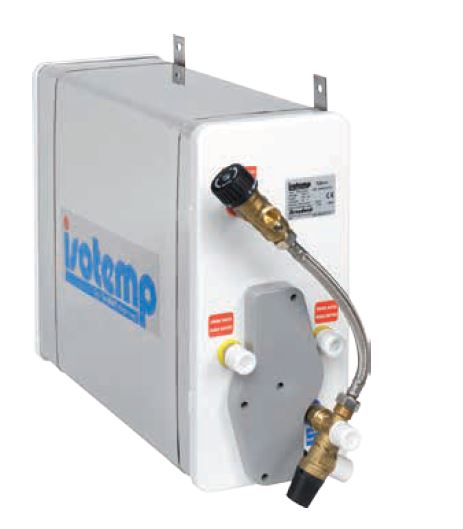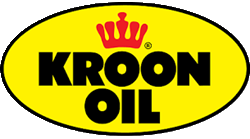
For many people, a boat is like a second home, but on the water. And just like in your home, you’d rather not be without hot water. Installing a water heater on your boat provides more comfort and is often very practical.
Here’s why an onboard water heater is indispensable for your boat, how one works, and the best way to install it. We’ll also offer advice on choosing the right one for your vessel. Our top recommendations are Webasto boilers.
Why a boat boiler is essential
Most boats come with conveniences like a navigation system, a hob and a small galley. So why wouldn’t you enjoy hot water on board too? We’ve listed eight benefits of having a water heater on board.
Having a nice warm shower
Let’s get a shower started. After a refreshing dip in the morning or a long day sailing in the sun, you’ll want to freshen up. If you’re docked at a marina, you can use the ablutions block. But with a boiler and an onboard shower, you can shower anywhere, just like at home. That’s much nicer than a cold shower.
Wash up with hot water
Even washing up is a doddle with hot water from a boiler. With a small boiler, say 15 or 20 litres, you’ll have enough capacity to get the dishes thoroughly clean. That way, everything stays fresh, even on longer trips.
Washing hands and hygiene
Got some fishing, tinkering or other bits and bobs to do while you’re out and about? You’ll want to give your hands, feet, or face a proper clean up afterwards. And let’s be honest, it’s a lot nicer with hot water than cold.
Doing the laundry and cleaning
Going away for a while and don’t want to have to keep going ashore? With a boiler, you can do small washes or rinse your clothes with warm water. Making soapy water is also a doddle. This way, you can keep the boat, clothes, and much more nice and clean.
Making cooking a lot easier
Making a cuppa or cooking your dinner is also a lot easier when you’ve got hot water on tap. Pop it straight into the pan and your meal will be bubbling away in no time, or you’ll have your tea or coffee brewed in a flash. With a boiler, it’s all as simple as can be, just like in your own kitchen.
Wise use of energy
Many marine boilers work with a heat exchanger linked to the engine’s cooling system. When the engine is running, the water in the boiler warms up by itself. Many models also have an electric element, so you have hot water when you’re stationary and plugged into shore power.
Getting ready for winter is easier
The season’s over and you’re getting the boat ready for winter? Even then, an onboard boiler is a godsend. You’ll have hot water on hand for thoroughly cleaning parts or keeping them frost-free.
Cold water? That’s a thing of the past!
Ultimately, an onboard boiler is an overall upgrade to your onboard comfort. You’ll have all the conveniences and can make guests feel more at home too. With an onboard boiler, you’re increasingly becoming a floating home.

How does an onboard boiler work?
A boiler on a boat works fundamentally the same way as one at home: cold water enters the tank, gets heated, and comes out warm. However, there are a few key differences.
At home, heating is usually done by gas or an electric boiler. On board, this happens via the engine’s cooling water system (heat exchanger) or an electric heating element. When the engine’s running, the heat exchanger automatically heats the water in the boiler. If the boat’s in the harbour, the boiler often switches to electricity.
Depending on the size of your boat, you can opt for a compact boiler of, for example, 15 litres or a larger one of 40 litres or more. You connect the water heater to the boat’s water system, with a cold water supply and an outlet to the tap or shower. Often, a pressure pump or hydrophore is needed to ensure the water flows with sufficient pressure.
Step-by-step plan: Fitting a boiler on your boat
Installing a boiler might sound complicated, but with the right preparation and a bit of know-how, it’s perfectly manageable. Just bear in mind that the process can vary from boat to boat. For instance, you’ll need to consider the space in the locker and the diameter of the hoses.
The necessary materials
For installing a boiler on your boat, you’ll need a few things. The following bits and bobs will come in handy:
- A suitable boiler
- Hoses and clamps
- Assembly tools
Step 1: Buy a suitable boiler
It starts with purchasing the right boiler. We recommend Webasto boilers. These boilers are suitable for onboard use and available with a capacity of 15 litres up to 75 litres.
Bear in mind the available space and the weight of the boiler. Assume a fully water-filled boiler. An overly heavy boiler could unbalance your boat.
Step 2: Find the right spot
Keep heat loss to a minimum by keeping the hoses between the engine and the boiler as short as possible. Also, prevent the cooling water circuit from being higher than the expansion vessel of the engine cooling system.
If that’s not possible, equip the cooling water hoses with a bleed nipple at the highest point. Install boilers with the drain tap at the bottom so the contents can be drained.
Step 3: Use the right hoses
Use a high-temperature, high-pressure, coolant-resistant water hose. Use robust, non-toxic hoses for the water hose. Clamp all hoses with stainless steel hose clips.
When it’s all hooked up:
- Fill the boiler with water.
- Let the pump run until water comes out of all the taps.
- Also bleed the hot water side, to prevent air bubbles in the system.
- Check if hot water is available when the engine is running or when shore power is connected.

Choose the right boat boiler at AB Marine Service
Not every boiler is right for every boat. So, it’s crucial to pick the correct one, especially considering the space you’ve got and what you’ll be using it for.
We recommend opting for a Webasto boiler from the Isotemp range. These boilers have been specifically designed for use on boats, ships, and yachts. At AB Marine Service, we supply these high-quality boilers directly from stock.
A durable design with stainless steel
Webasto boilers are made from stainless steel. This makes them ideally suited for operating on water. They last for years, without the tank becoming porous or leaking. Furthermore, they are easy to keep clean.
Compact dimensions
Webasto knows that onboard space is often at a premium. That’s why their boilers are compact. Every centimetre counts. You can often fit a compact Webasto water heater into a locker or under a seat without having to move other equipment.
A powerful heating element
The Webasto boilers cleverly utilise a heat exchanger. When the engine is running, you’ll have hot water in no time. Even when you’re plugged into shore power, the boiler can still provide hot water. This means you’ll practically never be without hot water.
Installing a Boiler? Let AB Marine Service be your partner
Installing a boiler on a boat requires a bit of preparation and know-how. If you’re a bit handy, take on the challenge and bring more comfort and convenience to your second home on the water.
Unsure which boiler would be best for your needs? Or perhaps you’ve got some questions about getting it fitted? Don’t hesitate to get in touch. We’ll gladly help you find the perfect water heater and can offer tips based on your boat’s specific details.












